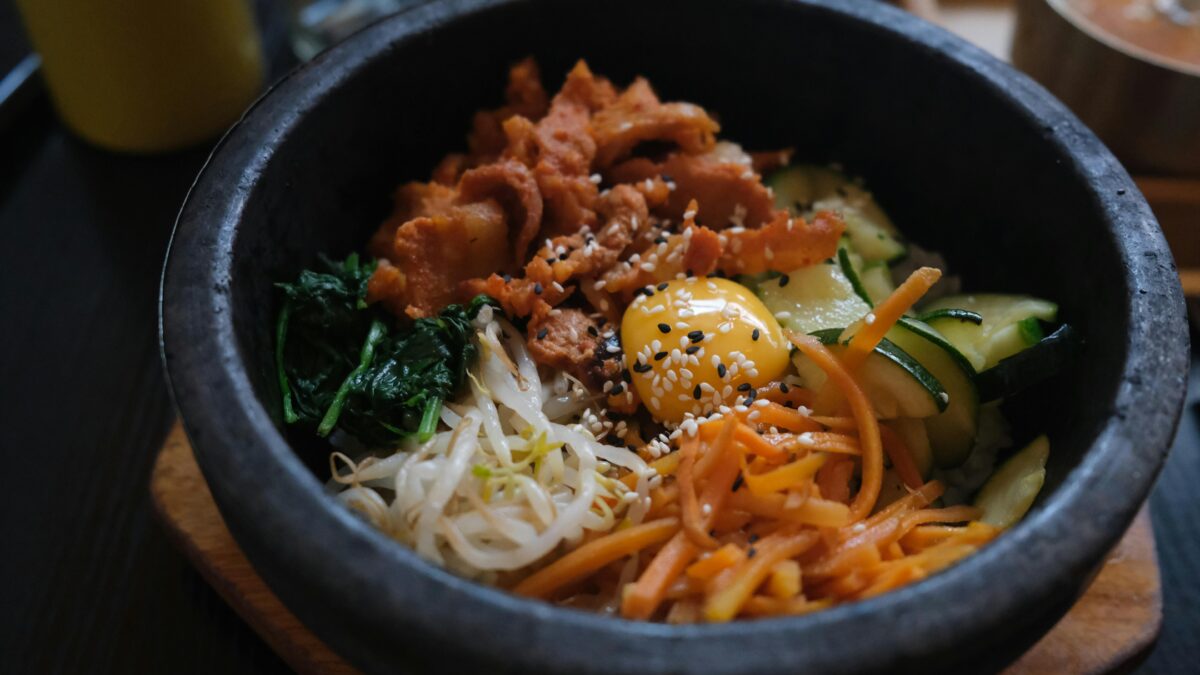Bibimbap: Korea’s Bowl of Harmony

Bibimbap (비빔밥), literally “mixed rice,” is one of Korea’s most iconic dishes.
Behind its seemingly simple appearance — rice topped with vegetables, meat, an egg, and spicy sauce — lies a philosophy of balance and harmony.
Each ingredient has its own color, texture, and purpose, creating a perfect blend of yin and yang, health and pleasure, body and earth.
A story from both palace and fields
The origins of bibimbap are as diverse and layered as the dish itself.
While there is no single definitive story, several fascinating theories shed light on how this iconic bowl came to be.
¤ The Royal Court Theory:
During the Joseon dynasty (1392–1897), royal kitchens prepared elaborate multi-course meals with dozens of side dishes (banchan). After ceremonies or ancestral rites, the remaining foods — still fresh and of high quality — were often mixed with rice to avoid waste and served to the royal attendants or even to members of the court. This refined version of bibimbap emphasized visual harmony, nutritional balance, and aesthetics — values deeply rooted in Confucian culture.
¤ The Farmers’ Meal Theory:
In contrast to its royal interpretation, another story attributes bibimbap to Korean farmers. During the busy harvest season, workers didn’t have time to sit down for a full meal. They would gather bits of vegetables, leftover side dishes, and rice into one bowl, add chili paste or soy sauce, and mix everything together for a quick, energy-rich meal in the fields. This practical origin connects bibimbap to Korea’s agrarian traditions and community-based lifestyle.
¤ The Lunar New Year Tradition:
Another explanation links bibimbap to Seollal (Lunar New Year’s Eve) customs. On this day, families would use up all the remaining banchan and side dishes from the year before preparing new food for the next year. Mixing them all together symbolized renewal — a way to start the new year fresh, without carrying over the “old” food or energy.
¤ Regional Evolution:
Over time, nearly every region of Korea developed its own style of bibimbap, each reflecting local ingredients and identity.
1- Jeonju bibimbap (전주비빔밥) is the most famous, known for its artful presentation, sesame oil aroma, and use of raw beef (yukhoe) and soy sauce–seasoned bean sprouts.
2- Jinju bibimbap often includes minced raw beef and a beef broth poured over the top.
3- Tongyeong bibimbap, from the southern coast, incorporates seafood like sea squirts and oysters, blending land and sea flavors.
4- Temple cuisine has its own version — completely vegetarian, emphasizing natural seasoning and simplicity.
Together, these variations show how bibimbap evolved from a humble, practical dish into a cultural symbol that unites Korea’s regions, classes, and histories in one bowl.
Key ingredients
A perfect bibimbap is all about balance:
Steamed white rice – warm and soft.
Namul (seasoned vegetables) – spinach, bean sprouts, zucchini, carrots, fernbrake.
Meat – usually marinated beef, stir-fried.
Egg – fried sunny-side up or raw in traditional versions.
Gochujang (red chili paste) – fermented, sweet, and spicy.
Mix it all together before eating — every bite becomes a harmony of flavors and textures.
Variations and modern twists
The dolsot bibimbap, served in a sizzling stone pot, is a crowd favorite — the rice at the bottom crisps up beautifully.
Modern versions include vegetarian, vegan, or fusion adaptations, making bibimbap one of Korea’s most flexible and global dishes.
More than food: a metaphor for Korea
Bibimbap is more than a meal; it’s a metaphor for Korean identity.
Different elements coexist in one bowl, each keeping its essence while creating unity.
It reflects the balance, diversity, and communal spirit at the heart of Korean culture.



